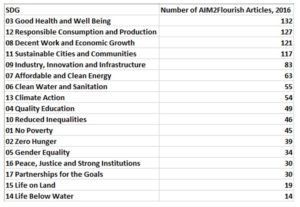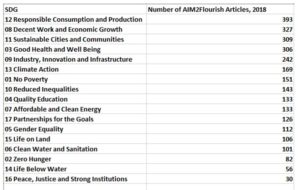Introduction
The Sustainable Development Goals (SDGs) of the United Nations established in 2015, have been endorsed by government, business and academic leaders around the world. In order to meet the targets specified by the related 2030 targeted initiative, the private and public sectors must work together with citizens to foster a more sustainable way of living on the planet. Businesses, particularly, can take a crucial role in the achievement of the SDGs due to their ability to innovate, respond to demands, and act quickly and efficiently, as mentioned by Scheyvens et al. (2016).
The SDGs are wide-ranging, encompassing a variety of focus areas. Each goal contains a number of sub-goals, which serve as metrics by which the progress made towards the achievement of the goal is measured. Some of the SDGs affect others even synergistically (Biggeri, Clark, Ferrannini, and Mauro, 2019). Another study has developed an international ranking of countries addressing the SDGs (Campagnolo, Eboli, Farnia, and Carraro, 2018).
Outline of the SDGs
Goal 1, No Poverty, hopes to “End poverty in all its forms everywhere,” with an example of one sub-goal being “By 2030, eradicate extreme poverty for all people everywhere, currently measured as people living on less than $1.25 a day” (United Nations, 2019). Goal 2, Zero Hunger, strives to “End hunger, achieve food security and improved nutrition, and promote sustainable agriculture,” as measured by a variety of metrics, including “By 2030, end hunger and ensure access for all people, in particular the poor and people in vulnerable situations including infants, to safe, nutritious and sufficient food all year round” (United Nations, 2019). Goal 3, Good Health and Well-being, hopes to “Ensure healthy lives and promote well-being for all at all ages” and aims at achieving “By 2030, reduce the global maternal mortality ratio to less than 70 per 100,000 live births” and “by 2030, end preventable deaths of newborns and children under 5 years of age, with all countries aiming to reduce neonatal mortality to at least as low as 12 per 1,000 live births and under-five mortality to at least as low as 25 per 1,000 live births” (United Nations, 2019). Goal 4, Quality Education, aims to “Ensure inclusive and equitable quality education, and promote lifelong learning opportunities for all,” with one sub-goal being that “By 2030, ensure that all girls and boys complete free, equitable and quality primary and secondary education leading to relevant and Goal-4 effective learning outcomes” (United Nations, 2019). Goal 5, Gender Equality, aims to “Achieve gender equality and empower all women and girls,” with two crucial sub-goals described as “End all forms of discrimination against all women and girls everywhere” and “Eliminate all forms of violence against all women and girls in the public and private spheres, including trafficking and sexual and other types of exploitation” (United Nations, 2019). Goal 6, Clean Water and Sanitation, aims to “Ensure access to water and sanitation for all” with one sub-goal being “By 2030, achieve universal and equitable access to safe and affordable drinking water for all” (United Nations, 2019). Goal 7, Affordable and Clean Energy, hopes to “Ensure access to affordable, reliable, sustainable and modern energy for all,” with one sub-goal being “By 2030, ensure universal access to affordable, reliable and modern energy services” (United Nations, 2019). Goal 8, Decent Work and Economic Growth, aims to “Promote sustained, inclusive and sustainable economic growth, full and productive employment and decent work for all,” with one sub-goal being to “Sustain per capita economic growth in accordance with national circumstances and, in particular, at least 7 per cent gross domestic product growth per annum in the least developed countries” (United Nations, 2019). Goal 9, Industry, Innovation and Infrastructure, is described as “Build resilient infrastructure, promote inclusive and sustainable industrialization and foster innovation,” with one sub-goal being “Develop quality, reliable, sustainable and resilient infrastructure, including regional and transborder infrastructure to support economic development and human well-being with a focus on affordable and equitable access for all” (United Nations, 2019). Goal 10, Reduced Inequalities, is described as “Reduce inequality within and among countries,” with one sub goal as “By 2030, progressively achieve and sustain income growth of the bottom 40 per cent of the population at a rate higher than the national average” (United Nations, 2019). Goal 11, Sustainable Cities and Communities, aims to “Make cities and human settlements inclusive, safe, resilient and sustainable” with one sub-goal being that “By 2030, ensure access for all to adequate, safe and affordable housing and basic services and upgrade slums” (United Nations, 2019). Goal 12, Responsible Consumption and Production, is defined as “Ensure sustainable consumption and production patterns,” with one sub-goal being “Implement the 10-year framework of programmes on sustainable consumption and production. All countries taking action, with developed countries taking the lead, taking into account the development and capabilities of developing countries” (United Nations, 2019). Goal 13, Climate Action, aims to “Take urgent action to combat climate change and its impacts,” with a sub-goal being to “Strengthen resilience and adaptive capacity to climate-related hazards and natural disasters in all countries” (United Nations, 2019). Goal 14, Life Below Water, is defined as “Conserve and sustainably use the oceans, seas and marine resources,” with one sub-goal being that “By 2025, prevent and significantly reduce marine pollution of all kinds, in particular from land-based activities, including marine debris and nutrient pollution” (United Nations, 2019). Goal 15, Life on Land, hopes to “Sustainably manage forests, combat desertification, halt and reverse land degradation and halt biodiversity loss” with a main sub-goal described as, “By 2020, ensure the conservation, restoration and sustainable use of terrestrial and inland freshwater ecosystems and their services, in particular forests, wetlands, mountains and drylands, in line with obligations under international agreements” (United Nations, 2019). Goal 16, Peace, Justice, and Strong Institutions, aims to “Promote just, peaceful and inclusive societies,” with one main sub-goal being to “Significantly reduce all forms of violence and related death rates everywhere” (United Nations, 2019). Goal 17, Partnerships for the Goals, aims to “Strengthen the means of implementation and revitalize the global partnership for sustainable development,” with a notable sub-goal being to “Strengthen domestic resource mobilization including through international support to developing countries, to improve domestic capacity for tax and other revenue collection” (United Nations, 2019).
Achievement of the SDGs
Generally, progress has been made towards achieving the SDGs since their initial creation in 2015. However, there are some notable areas where countries’ performance is not up-to-par. The lowest scores are achieved on SDG 13 (Climate Action), SDG 14 (Life Below Water) and SDG 15 (Life on Land). Even more alarming, not a single country achieved a “green rating,” meaning the SDG has been achieved, on SDG 14 (Life Below Water). The U.N. has confirmed the dire nature of this situation, as the Sustainable Development Report 2019 states, “Based on available data, trends on SDG 13 (Climate Action) and SDG 14 (Life Below Water) are alarming in most OECD countries which calls for further efforts to design and implement transformative policies to decouple economic growth from negative environmental impacts” (United Nations, 2019). Another study has similar findings (Janoušková, Hák, and Moldan, 2018).
AIM2Flourish
AIM2Flourish is a program spearheaded by the Fowler Center for Business as an Agent of World Benefit at the Weatherhead School of Management, Case Western Reserve University (AIM2Flourish, 2019). As participants, students are tasked with identifying and then interviewing a business leader whose company is doing well (financially) while doing good (addressing the SDGs). As students sort their interview subjects and subsequent articles into one or more related SDGs, their focuses provide valuable data on the relative popularity of exploring each issue, as well as the access to businesses addressing the goals that students have available.
In 2016, the most written-about SDG in AIM2Flourish was Goal 3, Good Health and Well Being with 132 associated articles. Closely following was Goal 12, Responsible Consumption and Production, with 127 articles. Rounding out the top three, Goal 8, Decent Work and Economic Growth had 121 related student articles. Goal 13, Climate Action, came in eighth, with 54 related articles. Goal 14, Life Below Water, came in last out of the 17 SDGs, with only 14 articles.
2018 sees the second-most written about goal from 2016, Goal 12, Responsible Consumption and Production achieved the top spot, with 393 articles. It is followed by Goal 8, Decent Work and Economic Growth, the third-most-popular goal in 2016, with 323 articles, and Goal 11, the third-most-popular goal in 2016, with 309 articles. Goal 13, Climate Action, jumped two ranks to number six, with 169 student articles. Goal 14, Life Below Water, was the second-least popular topic in 2018, with only 56 related articles.
Table 1: Number of A2IMFlourish articles by SDG, 2016

Calculations from data retrieved in November 11, 2019, from AIM2Flourish website: https://aim2flourish.com/innovations
Table 2: Number of A2IMFlourish articles by SDG, 2018

Calculations from data retrieved in November 11, 2019, from AIM2Flourish website: https://aim2flourish.com/innovations
Findings
The correlation between the lack of worldwide progress made towards SDG 14, Life Below Water, and its relatively low number of associated AIM2Flourish articles is disheartening. It is natural to see how students, faced with a lesser number of options for research, would choose other subjects to focus on. However, it stands to reason that encouragement from their associated institutions could work to mitigate this inequality and expand knowledge about this issue. It stands to reason that this encouragement is not being provided, as the students focus on the most popular goals for businesses to have in their sights, and the cycle perpetuates. Fortunately, SDG 13, Climate Action, ranks higher in this metric of awareness as relative to its progress towards achievement, and the positive effect of awareness, in this case, is clear.
As with achieving the SDGs themselves, the path forward towards achieving a more diverse set of AIM2Flourish reports is two-fold. Professors must educate students about all of the SDGs and their sub-goals, and perhaps even provide an additional incentive for students to study those less popular goals. However, companies must also do their part, holding the knowledge that their decision to focus only on the more societally visible goals has far-reaching implications.
For the aspirational SDGs to be achieved, a communitive effort is required. AIM2Flourish has clearly made progress in raising students’ awareness and interest in the SDGs, as evidenced by the overall increase in the articles. However, a more diverse set of projects would enrich the program for participants and interested spectators alike, and the program administrators cannot create this change alone.
(adsbygoogle = window.adsbygoogle || []).push({});
References
- Biggeri, M., Clark, D., Ferrannini, A., and Mauro, V. (2019), ‘Tracking the SDGs in an ‘integrated’ manner: A proposal for a new index to capture synergies and trade-offs between and within goals,’ World Development, 122, 628-647.
- Campagnolo, L., Eboli, F., Farnia, L., and Carraro C., (2018). Supporting the UN SDGs transition: methodology for sustainability assessment and current worldwide ranking. Economics: The Open-Access, Open-Assessment E-Journal, 12 (2018-10): 1–31.
- Janoušková S., Hák, T., and Moldan, B., (2018). Global SDGs Assessments: Helping or Confusing Indicators? Sustainability, 10(5): 1540.
- Sachs, J., Schmidt-Traub, G., Kroll, C., Lafortune, G., Fuller, G. (2019), Sustainable Development Report 2019. Bertelsmann Stiftung and Sustainable Development Solutions Network (SDSN), New York.
- Scheyvens, R., Banks, G., and Hughes, E. (2016), ‘The Private Sector and the SDGs: The Need to Move Beyond ‘Business as Usual’, Sustainable Development, 24 (6), 371-382.
- United Nations, “Sustainable Development Goals,” [Retrieved November 7, 2019], https://www.un.org/sustainabledevelopment/sustainable-development-goals/




